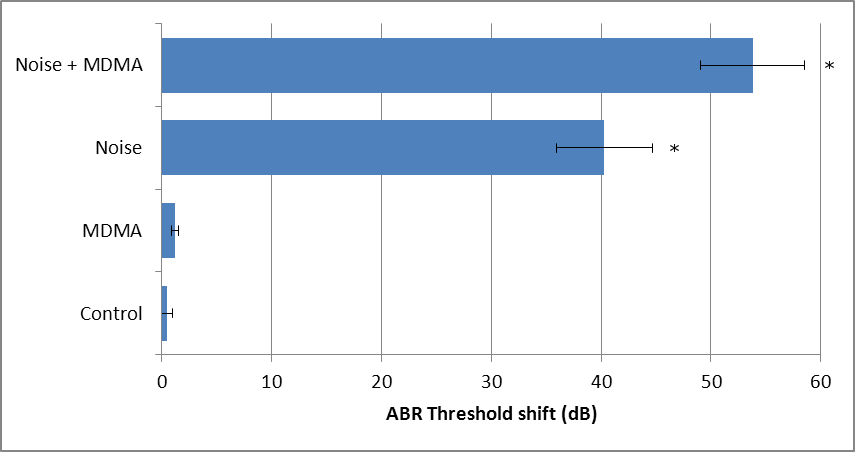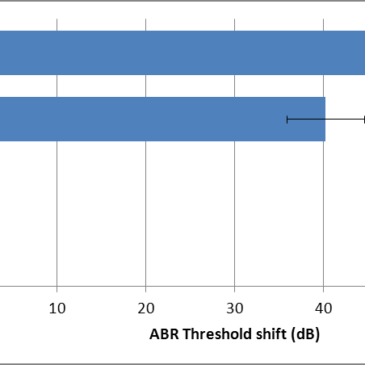The arrival of summer often delivers waves of music festivals. Attendees at festivals and other events featuring electronic dance music typically experience long periods of loud music. In addition, these events often are common settings for the use of the psychoactive drug “Ecstasy” (3,4-methylenedoioxy-N-methamphetamine; MDMA; Weir, 2000). Although research suggests that frequent exposure to loud music can impair hearing (Williams, Beach, & Gilliver, 2010), some have suggested that MDMA might also play a role in hearing loss due to how it modulates certain neurotransmitters that might be neuroprotective against noise exposure (Lendvai et al., 2011). This week’s STASH reviews an animal model study that explores how MDMA might affect noise-induced hearing loss (Church, Zhang, Langford, & Perrine, 2013).
Methods
- The researchers divided laboratory rats into four groups: Control (n=10), MDMA-only (n=9), Noise-only (n=9), and MDMA + Noise (n=9).1
- Researchers injected MDMA-only and MDMA + Noise rats with MDMA four times in 2-hour
increments. - Researchers injected rats in the Control and Noise-only group with saline on the same
schedule. - Following the final injections, researchers exposed the Noise-only and MDMA + Noise rats to 1 hour of continuous sound at 120dB.
- Researchers injected MDMA-only and MDMA + Noise rats with MDMA four times in 2-hour
- The researchers evaluated the rats’ hearing loss using auditory brainstem response (ABR) measurements, which measure electrical activity in the brain in response to pulses of sound.
- Researchers determined ABR hearing thresholds by assessing the quietest sounds that still evoked a measurable ABR response.
- Researchers calculated ABR hearing thresholds before and after experimental treatments to determine changes in hearing sensitivity. Larger positive shifts indicate greater hearing loss.
- Researchers also examined the inner ear structures of the rats under microscope to identify any tissue damage.
Results
- The researchers found that rats in the Noise + MDMA showed larger positive shifts in ABR thresholds as compared to Noise-only, whereas Noise-only showed larger positive shifts as compared to the Control group (Figure 1).
- The MDMA-only group was not significantly different from the control group.
- Under the microscope, Control rats and MDMA rats showed no signs of tissue damage whereas Noise-only and Noise + MDMA showed tissue damage. Additionally, tissue samples from Noise + MDMA showed damage to a larger amount of cells than the Noise-only group.

Figure. Threshold shift of Auditory Brainstem Response before and after treatment. Adapted from Church et al. (2013). Larger positive shift indicates greater hearing loss. *Noise+ MDMA average significantly higher than Noise, which is significantly higher than control according to post-hoc tests. Click image to enlarge.
Limitations
- The MDMA groups only capture the effects of a single experience of MDMA with or without noise. However, as “clubbers” might continue their behavior over the course of multiple events, it is unclear what the long-term effects would be.
- Because of the faster metabolic rate of rats, the authors had to administer a higher dosage and sustained injections to achieve a similar level of drug toxicity in humans. However, the authors note that the dosing regimen used was much more moderate than in other similar rat studies.
Conclusion
This study showed that although MDMA does not inherently produce any hearing loss; however, it can exacerbate any hearing loss that results from exposure to loud environments. This suggests that ecstasy users in club and concert environments might suffer an increased amount of noise-induced hearing loss than their non-using peers. The authors indicate that this could be due to MDMA’s reduction of serotonin and dopamine among users, two neurotransmitters that might play a protective role against noise induced hearing loss (Lendvai, et al., 2011). This suggests that other substances affecting serotonin and dopamine, such as LSD or certain anti-depressants, should be investigated as potential hearing loss contributors as well.
– Jed Jeng
What do you think? Please use the comment link below to provide feedback on this article.
References
Church, M., Zhang, J., Langford, M., & Perrine, S. (2013). ‘Ecstasy’ enhances noise-induced hearing loss. Hearing Research.
Lendvai, B., Halmos, G., Polony, G., Kapocsi, J., Horvath, T., Aller, M., . . . Zelles, T. (2011). Chemical neuroprotection in the cochlea: The modulation of dopamine release from lateral olivocochlear efferents. Neurochemistry International, 59(2), 150-158.
Weir, E. (2000). Raves: a review of the culture, the drugs and prevention of harm. Canadian Medical Association Journal, 162(13), 1843-1848.
Williams, W., Beach, E., & Gilliver, M. (2010). Clubbing: the cumulative effect of noise exposure from attendance at dance clubs and night clubs on whole-of-life noise exposure. Noise Health, 12(48), 155-158.
________________
[1] Full experimental methods can be found in Church et al. (2013).




